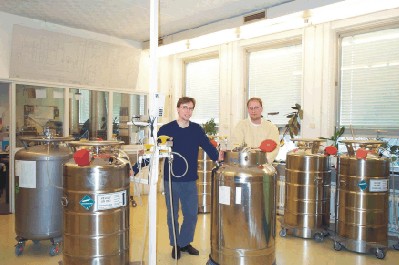
Liquid helium storage dewars.
In the physics department in Delft, about 35000 liters of liquid helium are used every year to cool experimental apparatus. Helium at atmospheric pressure boils at 4.2 K. By immersing a sample into liquid helium, the sample can be cooled. The sample can be either placed in a bath cryostat, where it bathes in liquid helium, or it can be attached to a dipstick that is lowered into a helium storage dewar. Sometimes helium is pumped through a pipe that is wrapped around a sample in a flow cryostat. The sample temperature can be controlled by regulating the flow of helium or by running current through an electric heater in the vicinity of the sample.

Liquid helium storage dewars.
To achieve lower temperatures, one can pump on the helium. The lower the pressure above the liquid, the lower the boiling point of the helium. By pumping on helium, it is possible to reduce the temperature to about 1.2 K. The common isotope of helium (4He) undergoes a superfluid transition at 2.2 K. Here is a description of the superfluid transition in liquid helium taken from a really excellent book on thermodynamics called States of Matter by David L. Goldstein.
When helium goes through the lambda point and becomes superfluid, it undergoes a change of state from a colorless transparent liquid into another colorless transparent liquid at the same density. Offhand, one would not expect the change to be visually dramatic, but it is quite a dramatic change and quite easily seen. When normal liquid helium is cooled by pumping away its vapor, it boils vigorously, swarms of tiny bubbles rushing to burst at the surface. But at the lambda point it suddenly stops boiling and becomes deadly calm - in the superfluid state it looks very much like a dry martini. The cessation of boiling is a consequence of its super heat conductivity. In an ordinary liquid, like water or normal helium, boiling occurs because hot spots develop, causing the vapor pressure to rise and overcome the local hydrostatic pressure. A bubble then forms and rises through the liquid. The superfluid, however, is too good a conductor of heat to allow hot spots to develop. The liquid continues to evaporate into gas (so that it can be further cooled by pumping away its vapor), but the evaporation takes place entirely at the liquid-vapor interface, leaving the bulk of the liquid quiet and undisturbed.
Since superfluid helium does not boil, there are no mechanical vibrations. This is an advantage when sensitive measurements are being made.
To reach temperatures below 1.2 K, a different isotope of helium (3He) is often used. This isotope boils at atmospheric pressure at 3.2 K. By pumping on liquid helium-3, temperatures of 300 mK can be reached.
Even lower temperatures can be reached by mixing 3He and 4He in a dilution refrigerator.